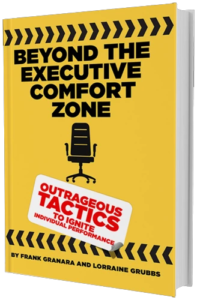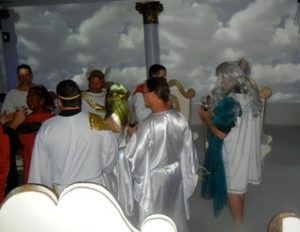Pushing Limits
Leadership Development Pushes Past Comfort Zone

A company’s business may not be in a danger zone, but leadership development efforts can’t wait until it is.
Even though business is good and the organization is humming along, challenging leaders to break out of their comfort zones and develop the skills needed to sustain and grow the business can provide for a stronger future.
Leadership expert Lorraine Grubbs said a company CEO she worked with on the book “Beyond the Executive Comfort Zone” was certain of this when he approached her for leadership development help for his team. Here was a group of senior leaders who had time and again proven their value and commitment to the growth of the company – and who Frank Granara, founder of General Insulation Company, wanted to hold on to. But in order to accelerate the company’s growth and explore new opportunities, these senior leaders would have to change their mindsets and adopt some new behaviors, said Grubbs, author and president of Lessons in Loyalty.
leadership development help for his team. Here was a group of senior leaders who had time and again proven their value and commitment to the growth of the company – and who Frank Granara, founder of General Insulation Company, wanted to hold on to. But in order to accelerate the company’s growth and explore new opportunities, these senior leaders would have to change their mindsets and adopt some new behaviors, said Grubbs, author and president of Lessons in Loyalty.
The 'We do it this way because we’ve always done it this way' approach would not suffice in the future. Let’s shake the senior executives up, Granara told her.
He wanted to double the company in size over the next five years and needed the team to think more globally. Leaders would have to cozy up to uncertainty, communicate better and collaborate more closely with one another. And they would have to be willing to pay more attention to external influencer and be open to looking beyond their own skills and expertise to find new insights and answers to business problems.
“I want you to take them to the edge of the cliff, throw them off and have them hanging on by their fingertips. I want this to be so uncomfortable for them,” Grubbs recalled the executive saying. And over the next two years, she and Granara took the group of senior executives on a boot camp-like journey, seemingly as strenuous as an 'Amazing Race' experience, so the group could 'get it'.
We started in the Theater – to get the leaders to speak candidly with one another – in  costume, on stage, in front of a live audience (stage fright); we went to NASA to examine what big picture thinking really looked like when putting a man on the moon; a trip to Gettysburg for a history lesson on high-stakes decision making where men's lives are on the line; and to another world, Costa Rica, where despite expectations of staying in a swanky hotel, the senior leaders had to rough it in a hostel, with no money, food or drink... Grubbs said.
costume, on stage, in front of a live audience (stage fright); we went to NASA to examine what big picture thinking really looked like when putting a man on the moon; a trip to Gettysburg for a history lesson on high-stakes decision making where men's lives are on the line; and to another world, Costa Rica, where despite expectations of staying in a swanky hotel, the senior leaders had to rough it in a hostel, with no money, food or drink... Grubbs said.
During the theater episode, a teammate froze in the middle of an impromptu speech he had to make in front of strangers, his teammates stood back in silence, watching their colleague flounder until the CEO stepped in and asked the leader questions helping him get back on track. Grubbs said, “That was a huge learning point for them.” Afterwards the leaders asked themselves some tough questions about that uncomfortable moment: “Why didn’t I help him?” “What made me just sit there?” “That was my fellow team member, and I allowed him to fail – that wasn’t the right thing to do.”
The stretch experiences brought the leaders to places where they had to think and move in different ways that are important for current and future leaders. Grubbs said the skills they worked on including decision-making in times of uncertainty, adding diverse perspectives and strategic thinking. All are among the competencies next generation leaders have to have for the sake of their business.
 While this example seems extreme, companies don’t have to devise a mountaintop experience to begin developing these skills in high potential talent. Leaders can introduce stretch opportunities in the workplace and make a significant and real-time impact on how people approach their work. Grubbs shared an example of a project she is working on with Granara overseeing younger, high potential talent. At a recent meeting, the group of leaders who’d been working together for a year, were asked to vote someone off the team “Survivor” style. They’d hand in their pieces of paper, and tell Grubbs and Granara why they decided on the given person. “These are things they’ve known about people but never said.” Afterwards, each leader had to call the person they’d voted off and share their rationale.
While this example seems extreme, companies don’t have to devise a mountaintop experience to begin developing these skills in high potential talent. Leaders can introduce stretch opportunities in the workplace and make a significant and real-time impact on how people approach their work. Grubbs shared an example of a project she is working on with Granara overseeing younger, high potential talent. At a recent meeting, the group of leaders who’d been working together for a year, were asked to vote someone off the team “Survivor” style. They’d hand in their pieces of paper, and tell Grubbs and Granara why they decided on the given person. “These are things they’ve known about people but never said.” Afterwards, each leader had to call the person they’d voted off and share their rationale.
This activity, facilitated by a learning professional, wasn’t for the faint of heart. However, the young employees learned some valuable lessons about communication and the value of each member of the team and having difficult conversations. But before getting to places like this, Grubbs said it is important for learning leaders to work with team supervisors to figure out where their department is and what the company needs.
Shake-ups like this are important, Grubbs said. Leaders at all levels may have all the right intentions but without developing next generation leadership skills, company growth will lag.
Published in CLO Magazine, 6/2016
Lorraine Grubbs is an author, speaker and business consultant working to help companies create "Happy Workplaces". Learn more about what she does at: www.lorrainegrubbs.com
